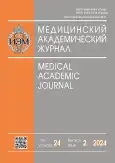Effects of combined action of proline-rich peptides of human saliva with antimicrobial proteins
- Authors: Sukhareva M.S.1
-
Affiliations:
- Institute of Experimental Medicine
- Issue: Vol 24, No 2 (2024)
- Pages: 137-140
- Section: Original research
- URL: https://journal-vniispk.ru/MAJ/article/view/271140
- DOI: https://doi.org/10.17816/MAJ630013
- ID: 271140
Cite item
Abstract
BACKGROUND: The substances that make up mixed saliva exhibit activity against bacteria, viruses and fungi. Among them are various cationic antimicrobial peptides: alpha- and beta-defensins, cathelicidins, histatins, but their concentration is relatively low. On the other hand, saliva widely contains a fraction of proline-rich proteins and products of their proteolysis — peptides, the functions of which currently remain poorly studied and unclear. The study of the antimicrobial activity of proline-rich proteins, in particular, when they act together with antimicrobial peptides, and the deciphering of the molecular and cellular basis for the implementation of the protective functions of proline-rich peptides is an urgent task in medicine and biology. The data obtained will help to understand the mechanisms of anti-infective protection of the oral cavity with the participation of the innate immune system, and in the future will allow the creation of drugs based on proline-rich proteins in humans and animals.
AIM: Study of the individual antibacterial action of proline-rich salivary proteins, their combined action with the antimicrobial proteins lactoferrin and lysozyme, as well as with one of the most significant endogenous protective peptides — cathelicidin LL-37 on the formation of bacterial biofilms.
MATERIALS AND METHODS: Human lactoferrin and egg lysozyme were used in the work. The minimum inhibitory concentrations of peptides against gram-negative and gram-positive bacteria were estimated using serial dilutions in a liquid nutrient medium. Using serial dilutions using the “chessboard” method, it was shown that proline-rich proteins can increase the antibacterial activity of innate immunity peptides present in the oral cavity. The ability of combinations of cationic proline-rich peptides with cathelicidin LL-37 to prevent the formation of bacterial biofilms was studied.
RESULTS: In the presence of proline-rich peptides, the antimicrobial activity of some antimicrobial peptides and proteins present in saliva against planktonic bacteria increases. The combined action of proline-rich proteins with LL-37 increases the inhibition of bacterial biofilm formation.
CONCLUSIONS: As a result of the study, it was shown that the analyzed cationic proline-rich peptides of human saliva exhibit anti-inflammatory effects, which suggests their significant role in the regulation of inflammatory processes in the oral cavity, as well as their participation in recovery processes.
Keywords
Full Text
##article.viewOnOriginalSite##About the authors
Maria S. Sukhareva
Institute of Experimental Medicine
Author for correspondence.
Email: masha.suxareva@yandex.ru
ORCID iD: 0000-0002-5351-7199
Junior Researcher in the Group for Studying the Biological Activity of Antimicrobial Peptides of the Laboratory of Alternative Antimicrobial Biopreparations of the Molecular Basis of Microorganism-Human Interaction Scientific and Educational Center of the World-Class Scientific Center for Personalized Medicine
Russian Federation, Saint PetersburgReferences
- Pfaffe T, Cooper-White J, Beyerlein P, et al. Diagnostic potential of saliva: current state and future applications. Clin Chem. 2011;57:675–687. doi: 10.1373/clinchem.2010.153767
- Carpenter G. The secretion, components, and properties of saliva. Ann Rev Food Sci Technol. 2013;4:267–276. doi: 10.1146/annurev-food-030212-182700
- Vavilova TP, Yanushev OO, Ostrovskaya IG. Saliva. Analytical capabilities and prospects. Moscow: BINOM; 2014. 312 p. (In Russ.) EDN: HXNTHV
- Trindade F, Amado F, da Costa JP, et al. Salivary peptidomic as a tool to disclose new potential antimicrobial peptides. J Proteomics. 2015;115:49–57. doi: 10.1016/j.jprot.2014.12.004
- Righino B, Pirolli D, Radicioni G, et al. Structural studies and SH3 domain binding properties of a human antiviral salivary proline-rich peptide. Biopolymers. 2016;106(5):714-725. doi: 10.1002/bip.22889
- William M Shafer, editor. Antibacterial peptide protocols. Totowa NJ, Humana Press Inc.; 1997. 255 p.
- Merritt JH, Kadouri DE, O’Toole GA. Growing and analyzing static biofilms. Curr Protoc Microbiol. 2005;Chapter 1:Unit 1B.1. doi: 10.1002/9780471729259.mc01b01s00
Supplementary files






